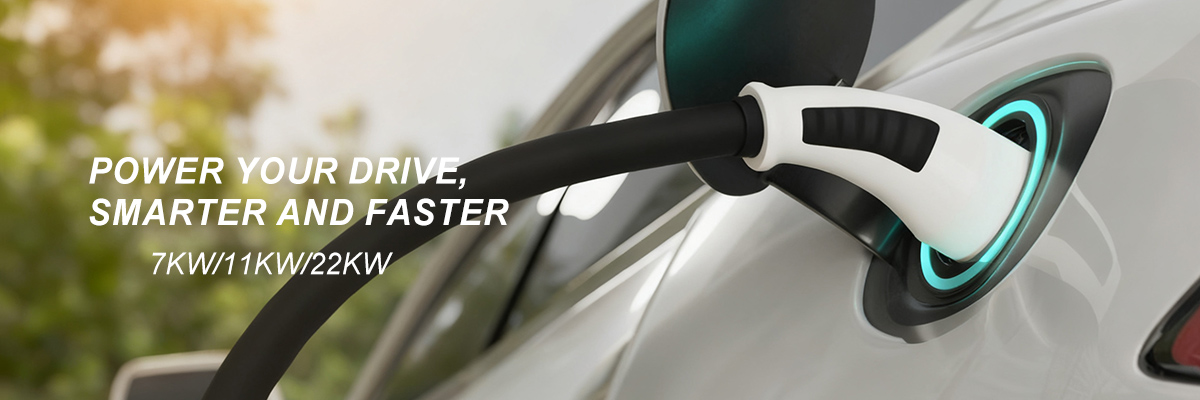
Wall-Mounted EV Charger 7kW / 11kW / 22kW | Smart Type 2 EV Charging Station for Home & Commercial Use
The Wall-Mounted EV Charger provides a powerful, safe, and intelligent charging solution for modern electric vehicles. Available in 7kW, 11kW, and 22kW, it supports both residential and commercial installations.
Compact in design yet robust in performance, this Type 2 charger supports OCPP 1.6 communication for remote control, monitoring, and payment integration. Optional credit card reader and Dynamic Load Management (DLM) make it an ideal choice for public charging networks and smart home systems.
Powerful All-in-One Design – Compact body integrating safety, intelligence, and efficiency.
Flexible Power Options – 7kW / 11kW / 22kW configurations for home or public charging.
Smart Connectivity – Supports OCPP 1.6 for remote monitoring and billing integration.
Payment Ready – Optional RFID and credit card reader for commercial applications.
Dynamic Load Management – Balances grid power and prevents overload automatically.
Easy Installation & Maintenance – Wall-mounted design, plug-and-play setup.
High Protection – IP55 weatherproof and IK10 impact resistance for long-term reliability.
Specifications of Wall-Mounted EV Charger
| Data | |||
| Model | ARAC132EN | ARAC316EN | ARAC332EN |
| Working Voltage | AC 220/230V | AC 380/400V | AC 380/400V |
| Frequency | 50/60Hz | 50/60Hz | 50/60Hz |
| Rated Power | 7kW | 11kW | 22kW |
| Power Supply Circuit | 1-phase | 3-phase | 3-phase |
| Rated Maximum Power | 32A | 16A | 32A |
| IP Degree | IP65 | IP65 | IP65 |
| Cable Length | 5m | ||
| Working Environment | |||
| Working Temperature | -30℃—+50℃ | ||
| Working Humidty | 5%~95%HR | ||
| Maximum Altitude | <2000m | ||
| The Cooling Way | Natural Air Cooling | ||
| Product Performance | |||
| Over Voltage Protection, Under Voltage Protection, Overload Protection, Leakage Protection, Ground Protection, Over Temperature Protection, Lightning Protection, Short Circuit Protection | |||
| Safety Standards | GB/ T20234,GB/ T18487,NB/ T33008,NB/ T33002/ IEC61851-2 1-2:2021 | ||
| Applicable Environment | Home/ Indoor/ Outdoor | ||
| Function | |||
| Communication Iprotocol | OCPP 1.6 | ||
| RCD | Type A/ Type B(Optional) | ||
| Networking Method | 4G or Ethernet Optional | ||
| Physical Size | |||
| Fuselage Size | 355*250*93mm | ||
| Installation Mode | Pillar Stand Mounted or Wall Mounted | ||

Residential EV Charging: Easy home wall-mounted setup for daily charging.
Commercial Buildings: Smart charging for offices, shopping malls, or hotels.
Parking Lots & Fleet Stations: Reliable and scalable charging infrastructure.
Public Charging Networks: OCPP compatibility allows integration into management platforms.

Q1: What types of vehicles are compatible with this wall-mounted EV charger?
A1: This charger is equipped with a Type 2 connector, compatible with most electric vehicles and plug-in hybrids in Europe and many global markets.
Q2: What power options are available?
A2: The charger offers 7kW, 11kW, and 22kW versions to suit both home and commercial use. 7kW is ideal for residential charging, while 11kW and 22kW are designed for faster charging in public or business locations.
Q3: Does it support smart features like OCPP or mobile app control?
A3: Yes. It supports OCPP 1.6 (JSON) for remote monitoring, billing, and integration with charging management systems. Optional Wi-Fi, 4G, or Ethernet modules enable cloud connectivity and app control.
Q4: Can users pay by credit card or RFID card?
A4: Yes, the charger supports RFID authentication and can be equipped with an optional credit card reader, perfect for commercial or shared charging stations.
Q5: What is Dynamic Load Management (DLM)?
A5: DLM automatically adjusts the charging power based on the available electrical capacity, preventing overload and ensuring optimal energy distribution when multiple chargers operate simultaneously.

We are a leading innovator and manufacturer in lithium battery technology, dedicated to engineering and manufacturing high-quality LiFePO4 solar batteries and power systems. Our core business involves the complete lifecycle of product development, from initial design to final production of dependable lithium battery packs. We proudly serve diverse sectors with customized solutions for energy storage, critical backup power systems, and compatible inverters and solar panels.
Based on automated production technology, Arcvolt are able to meet our customers' product needs quickly. However, the exact lead time depends on the quantity and the season you place the order.
Usage scenario: wall-mounted batteries, rack-mounted batteries, and stacked batteries. Voltage: 48V or 51.2V batteries, low/high voltage batteries Application: Residential storage batteries, industrial and commercial energy storage batteries.
While the typical home system uses 2 or 3 batteries, the perfect number for you is a personal choice. It all comes down to what you want to power during a grid outage and for how long. Do you need to run just the essentials or your whole house?
Yes, going completely off-grid is possible, but it's a significant step beyond standard solar with battery backup. A true off-grid system requires a much larger solar array and battery bank to power your home 24/7, making it a substantial investment. You also need a reliable backup source, like a generator, for days without sun. It's important to note that in North Carolina, disconnecting a home from the utility grid can be a complex process.
We accept EXW,FOB,CFR,CIF,etc. You can choose the one which is the most convenient or cost effective for you.
Absolutely. Our in-house design team specializes in OEM and ODM projects to bring your brand's vision to life. Simply provide us with your concept, high-resolution logo, and any text or images you'd like to include. We will then create a professional design proof for your final approval before we proceed.
Certifications are a key part of our pre-production checklist. We start by confirming with you which certifications are needed. These requirements are then integrated into the project timeline to ensure completion before shipment, and are formally documented in the signed agreement.
We offer lifetime technical support, with our engineers available 24/7 to provide prompt online assistance.
Yes, most of Arcvolt's inverters are designed to be scalable, meaning your system can grow with your needs. However, it's something that requires planning. Before adding more panels, it's essential to confirm that your current inverter can handle the additional power. We always recommend discussing your future plans with a professional to ensure your initial system is future-ready.
It depends on whether you have batteries. For Solar + Battery systems: A hybrid inverter is essential. It seamlessly manages power from panels and batteries in a single unit. For Solar-Only systems: Traditional inverters (like string or microinverters) are an option. The main advantage of a hybrid inverter is that it eliminates the need for a separate charge controller, making for a cleaner and more efficient installation.
Selecting the right inverter is one of the most important decisions you'll make for your solar project. While technical specifications matter, the long-term value comes from the manufacturer. Arcvolt advise customers to look beyond the data sheet and assess the company on these five critical points: their warranty, quality control standards, customer service responsiveness, installation support, and competitive pricing.
Generally, you want the inverter's size to match your solar array's power output. So, if you're installing a 5,000-watt solar system, you'll need an inverter of at least 5,000 watts to handle the load.
Yes, samples are available upon request as part of the qualification process for bulk orders. Please reach out to a member of our customer service team to discuss your specific requirements and they will assist you with the next steps.
Think of it as your personal energy bank. During the day, it saves up all the extra, unused power your solar panels generate. Then, you can draw from that stored energy whenever you need it—at night, during a power outage, or to avoid high-cost peak hours. For homeowners, this means energy independence and peace of mind. For businesses, it's a powerful tool to slash electricity bills.
Smart inverters are central to a system's reliability. Our inverter provide a constant stream of performance data, giving you a real-time view of your entire solar array. If a problem arises, the inverter's diagnostic tools can pinpoint the exact issue, which significantly speeds up repairs. This intelligent monitoring is key to preventing small problems from becoming big ones and guarantees the consistent, reliable operation you expect.
MPPT is a crucial technology that ensures you're not wasting sunlight. Because sun conditions are always changing, there is always a single, optimal point where your solar panels operate most efficiently. MPPT is the brain that constantly scans and adjusts the system to find and stay locked onto that "maximum power point." This guarantees you are harvesting the most energy possible from your panels at any given moment.
It's a question of priorities, and the logical first step is always generation. You have to make power before you can store it. Solar panels directly reduce your utility bills by producing electricity. Batteries give you control over when you use the excess electricity you've already made. We help our customers design a system that maximizes their solar panel array first, as this delivers the biggest and fastest return on investment.
A grid-tied inverter is the standard type used to reduce your electricity bills with solar. It safely connects your solar system to the utility's grid, allowing you to seamlessly feed any surplus power you produce back to the utility. In return, you receive credits on your bill for that energy, a process known as net metering. For safety, these inverters automatically shut down during a power outage.
The exact amount of power you generate is unique to your home and depends on your system's size, your roof's orientation, and how much direct sun you get. However, to give you a real-world idea, our typical 6kW home system can produce around 30kWh of electricity on a clear, sunny day. For most households, that's more than enough to cover all of your energy needs for a full 24 hours.